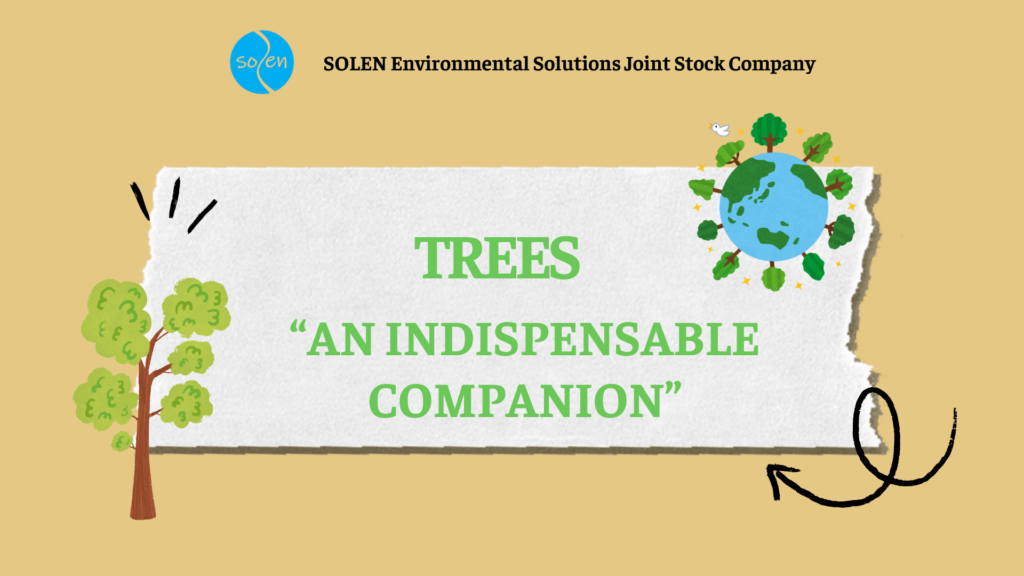In the current context, as the industry develops more and more, their impact on nature becomes increasingly clear. Therefore, preserving the ecosystem is one of the urgent things. One of the actions that can help preserve natural nature is planting trees. In this article, we will summarize the benefits of trees for people and nature as well as some suitable crop plant species.
I. Benefits of trees
1. Trees help regulate the temperature and fight climate change: Forests are carbon sinks that help slow climate change by removing carbon from the atmosphere and storing it in trees and soil. Today, trees absorb 30% of global emissions each year. And when we burn or cut them down, all that pollution is released into the air. A recent study estimates that between 2010 and 2050, global deforestation will result in 3.5 to 4.2 billion tons of greenhouse gases entering the atmosphere each year. Even small amounts of air pollution contribute to countless health problems that affect society disproportionately.
2. Trees provide shelter for millions of species that protect us from disease: 50% of Earth’s plants and animals live in tropical forests. We now know that nearly two million species worldwide are at risk of extinction. A quarter (25%) of our medicines come from plants found in tropical forests and if coral reefs are included, the figure is 40-50%. However, as we continue to encroach and destroy natural habitats, we will lose these valuable species and create greater threats. Currently, three out of every four new infectious diseases in humans are caused by animals, and this number is only increasing as we move into wild habitats and increase our exposure. But studies show that high levels of biodiversity actually have a “diluting effect” on disease in the host, making it less likely to spread to humans. In other words, protecting forest habitats and the species that live in them could prevent the next pandemic.

Figure 1. Trees and the Earth (Source: Pinterest)
3. Trees cool our cities: Trees cool the Earth by blocking sunlight and creating shade – air temperatures under their canopy can be 13.9°C cooler than the air around. They can also reduce energy useage for cooling and heating. The United States Department of Energy declare that planting trees around your home can reduce the amount of heat absorbed from the sun from windows and roofs, thereby reducing air conditioning costs. Trees also help control climate through transpiration – a process in which water is drawn up through the soil by roots and evaporated from leaves. The surrounding air cools as the water turns into steam. One tree can add 50,007 liters of water to the atmosphere each year [1]. To combat the heating effects of concrete in cities, studies show we need canopy coverage of at least 40%. With more than half of the world’s population living in cities – which are notoriously hotter due to concrete, poorer air quality, shade and limited green space, buildings – we must do our best strength to cope with the heat.
4. Trees protect against floods and water pollution: Mature trees protect communities from flash floods and landslides by stabilizing the soil and absorbing 1,500 to 2,000 liters of water per year [1]. On the other hand, a lack of trees can lead to increased runoff and flooding. Tree roots also filter toxic chemicals and pollutants from stormwater runoff into lakes, streams and rivers. Trees are beneficial for mental health: Believe it or not, if you live in an atmosphere full of trees, your spirit can be much more comfortable. Trees in rural and especially urban areas benefit our mental and physical health. Studies show that urban trees provide better health outcomes for local communities, including improved cardiovascular function, greater thermal comfort, and reduced anxiety. [1]
II. Some popular plants
In this article, we will focus on listing some types of plants for urban and coastal areas, areas with potential for planting trees to maintain a strong cold habitat for humans and protect the natural ecosytem.
1. Trees for urban areas
Based on the soil, space, climate and temperature, light and humidity to choose the appropriate tree species to plant. Trees planted in Urban areas often are trees that provide shade and bring aesthetics to the landscape. Helps create a cool green space, absorb and purify dust and pollution caused by vehicles. The following are trees that should be planted in Urban areas:
Yellow Flamboyant (Copperpod); Saman (Rain tree, Monkey pod, Filinganga, Gouannegoul, Marmar, T’amalini, Palo de China); Lingoum macrocapum (Kurz) O; Freshwater mangrove (Indian Oak, Indian Putat, Itchy Tree, Stream Barringtonia); Terminalia mantaly (Dwarf Geometry Tree, Madagasca Almond); White Champaca (Michelia Alba, White Sandalwood, White Jade Orchid Tree); Purple bauhinia (Butterfly-tree, Orchid-tree, Camel’s foot tree, Tapak kudakekapur); Golden Shower Tree (Cassia fistula Linn.); Chekring (Coral bean, Purple Coral-tree, Swamp erythrina, Gllito, Bucayo); African tulip tree (Fountain tree, Spathodea campanulata); Casuarina-tree; Giant Crape-myrtle (Queen ‘s Crape-myrtle, Banabá Plant for Philippines, Pride of India, Queen ‘s flower); Syzygium campanulatum (Syzygium oleinum, họ Sim Myrtaceae); Crape-myrtle; Yellow bells (Tecoma stans); tamanu (mastwood, pannay tree); Cassia siamea Lam; Cinnamomum camphora; Dipterocarpus alatus Roxb.; Chukrasia tabularis.
2. Green trees for areas next to the sea – Shrubs and similar plants:
– Shrubs are plants that are slightly smaller than trees, so they can be used to form hedges.For a garden by the sea, some typical plants include: Chinese orange blossom;Red cotton swab;
– Palm trees: Some species of palm trees such as Palmetto;Phoenix dactylifera – a multi-stemmed plant, can grow up to 30 meters.[2]




 Tiếng Việt
Tiếng Việt 日本語
日本語